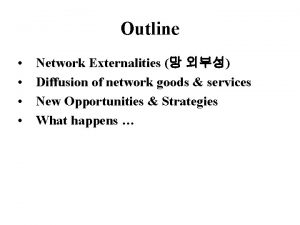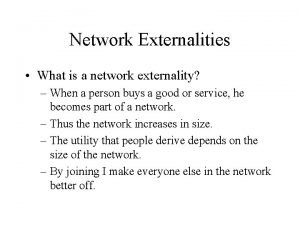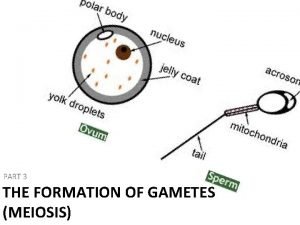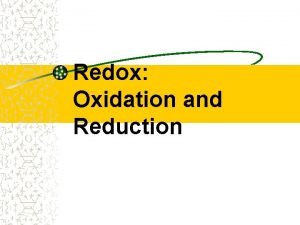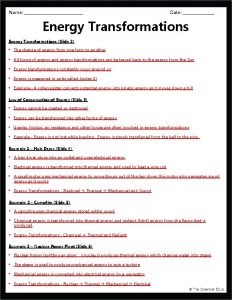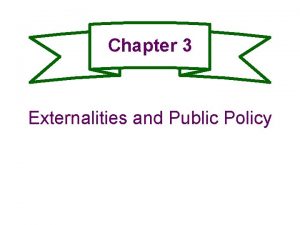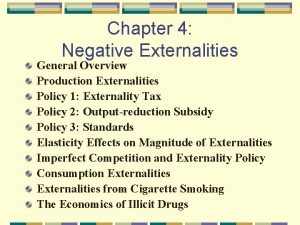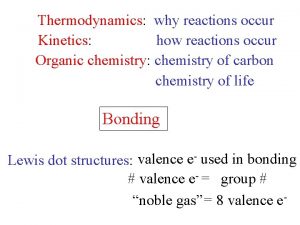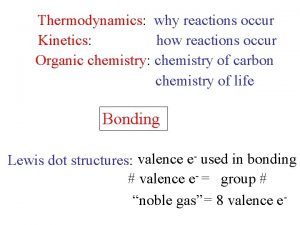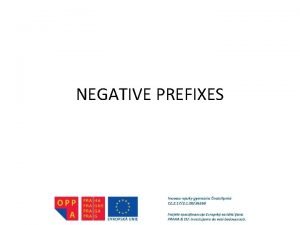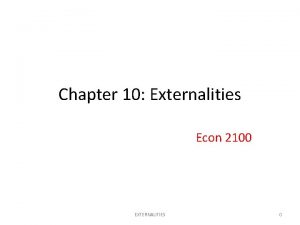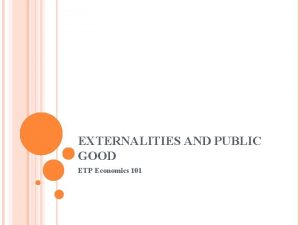Negative Externalities Negative Externalities Negative Externalities occur when
















- Slides: 16

Negative Externalities

Negative Externalities �Negative Externalities: occur when production or consumption of a good impacts a third party in a negative manner. o The true costs are not paid for by the producer or consumer �Negative externality of production: occurs when the making of a product creates spillover costs to others (Example; Tar Sands). o The external costs suffered by others increases the overall social costs which exceed the costs to the individual (MSC > MPC) o If the market functioned, it would result in a higher price (P ) and a reduced quantity consumed (Q )

�Example; Coal is produced with significant air pollution as a by-product, along with the deaths of hundreds of miners working in dangerous conditions every year. �Negative externality of consumption: occurs when the use of a product creates spillover costs to others (Example; Smoking, Gambling) o The marginal social benefits are less than the benefits enjoyed by the private consumer (MSB <MPB)

o Example; Automobile usage creates negative externalities of consumption with air pollution and car accidents o Society will eventually have to pay some of the costs of this increased usage of cars (health & environmental costs) o This cost to others reduces the overall benefit to society

Production Externalities. Solutions �Some governments choose to tax the product that produces the negative externality o A tax of this sort will increase the marginal private costs to the firm producing the product, shifting MPC left. o This forces producers to ‘internalize the externality’ thereby raising the price (PS) and reducing the output towards the socially optimal level (QS)

Overprovision of Demerit Goods �Demerit Goods: are goods/service with negative externalities and are deemed politically undesirable �They are goods which are rivalrous and exclusive, so the market will provide them (Example; Cigarettes, Alcohol, Gambling) �However, they have net social costs which are passed onto third-parties �A market will provide a private optimum level which is more than the social optimum (MSC > MSB). �A government could respond to this over-provision and attempt to decrease resource allocation towards the socially

�There is an important conceptual distinction between a demerit good and a negative externality. �A negative externality occurs when the consumption of a good has measurable negative consequences on others who do not consume the good themselves. �Example; Smoking is an example of a negative externality. o It not only affects you, but the people around you (second hand smoking). �By contrast, a demerit good is viewed as undesirable because its consumption has negative effects upon the consumer. �Correcting for negative externalities requires that government get producers to internalize these costs

�There are three methods the government can use to reduce the demand for demerit goods: � 1) Negative Advertising o Reduces the demand for the demerit good by changing tastes and preferences, shifting the MPB curve leftward o Example; Anti-smoking campaigns

� 2) Taxation o The government can target supply by levying a tax on a good which forces market actors to pay the costs to society instead of third-parties. o This reduces the supply and shifts the supply curve upwards by the amount of the tax o In this way, the government attempts to reduce the quantity consumed to the socially desirable level (QS)

o The tax revenue also could be passed on to the people who suffer the externality � 3) Legislation limit or Prohibition o If the negative externalities are very significant, the government might use the law rather than taxes o It might restrict or totally prohibit the sale and ownership of the demerit good o The aim would be to reduce quantity supplied to zero o Its effectiveness would depend on the effectiveness of the law, including the policing of parallel markets o Example; Gun ownership, Heroine use

�Black markets often emerge to sell the good and underground economies are formed �Strict enforcement drives up the price of the good and increases the incentives for producers to remain in business

Responses to Externalities: Summary �Governments can influence the provision of goods or services using the following approaches: Increase Provision of Merit goods Decrease provision of demerit goods Affect on Supply and Demand Subsidize merit goods Taxing demerit goods Changes supply (shift) Positive advertising for the good Negative advertising for the good Changes demand (Shift) Direct provision of merit goods Outlawing provision of demerit goods Changes quantity supplied (Movement along curve)


Example; Market Failure. Pollution � Question: What is meant by ‘market failure’? Explain why pollution may cause market failure. Solution- (10 Marks/20 Minutes) � Market Failure: is a situation in which a market leads to either an under-allocation or over-allocation of resources to a specific economic activity � Negative Externalities: are costs not paid for by the producer but are transferred onto other parties involved. o Adds to private social costs, which shifts society’s supply curve left o If the market functioned, it would result in a higher price and a reduced quantity

�Air pollution from burning fossil fuels is a negative externality because it causes damage to crops, (historic) buildings and public health. �This can be modeled with the diagram below, �Marginal social cost (MSC) is greater than Marginal private cost (MPC)

�The market ignores the externality and provides more pollution than is socially desirable �Polluters enjoy a lower production cost because the firm does not bear the entire cost �The free-market price is lower than the price when the costs of the externality are taken into account �There is overproduction of pollution and resources that are used in industries creating this pollution could be better allocated elsewhere �This leads to allocative inefficiencies
 Externalities in environmental economics
Externalities in environmental economics Myspace
Myspace Pure public good
Pure public good Externalities problems and solutions
Externalities problems and solutions Network externality meaning
Network externality meaning Deadweight loss in positive externality
Deadweight loss in positive externality Where does negative selection occur
Where does negative selection occur Run on sentences
Run on sentences Crossing over occurs during:
Crossing over occurs during: Most welding environment fires occur during
Most welding environment fires occur during Oxidation cannot occur without
Oxidation cannot occur without Subpolar low
Subpolar low Identify the energy transformations that occur in a guitar
Identify the energy transformations that occur in a guitar Metallic bonding occurs between atoms of
Metallic bonding occurs between atoms of Sensory receptors in vertebrates
Sensory receptors in vertebrates Does crossing over occur between homologous chromosomes
Does crossing over occur between homologous chromosomes Why do earthquakes occur
Why do earthquakes occur

